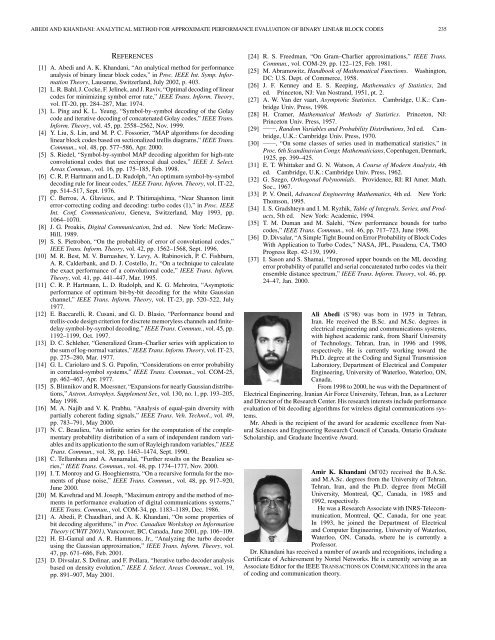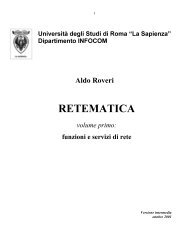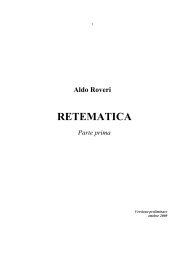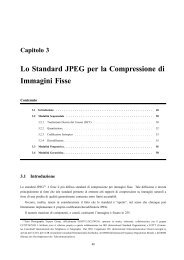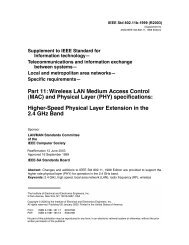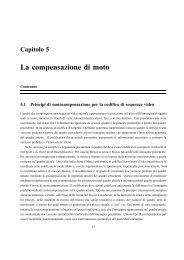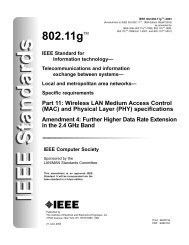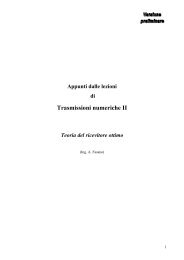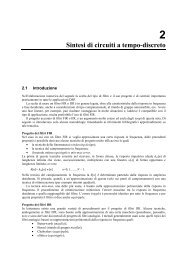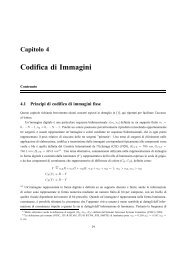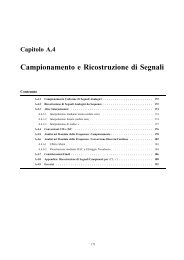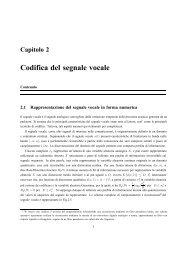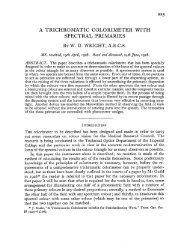An Analytical Method for Approximate Performance ... - IEEE Xplore
An Analytical Method for Approximate Performance ... - IEEE Xplore
An Analytical Method for Approximate Performance ... - IEEE Xplore
You also want an ePaper? Increase the reach of your titles
YUMPU automatically turns print PDFs into web optimized ePapers that Google loves.
ABEDI AND KHANDANI: ANALYTICAL METHOD FOR APPROXIMATE PERFORMANCE EVALUATION OF BINARY LINEAR BLOCK CODES 235<br />
REFERENCES<br />
[1] A. Abedi and A. K. Khandani, “<strong>An</strong> analytical method <strong>for</strong> per<strong>for</strong>mance<br />
analysis of binary linear block codes,” in Proc. <strong>IEEE</strong> Int. Symp. In<strong>for</strong>mation<br />
Theory, Lausanne, Switzerland, July 2002, p. 403.<br />
[2] L. R. Bahl, J. Cocke, F. Jelinek, and J. Raviv, “Optimal decoding of linear<br />
codes <strong>for</strong> minimizing symbol error rate,” <strong>IEEE</strong> Trans. In<strong>for</strong>m. Theory,<br />
vol. IT-20, pp. 284–287, Mar. 1974.<br />
[3] L. Ping and K. L. Yeung, “Symbol-by-symbol decoding of the Golay<br />
code and iterative decoding of concatenated Golay codes,” <strong>IEEE</strong> Trans.<br />
In<strong>for</strong>m. Theory, vol. 45, pp. 2558–2562, Nov. 1999.<br />
[4] Y. Liu, S. Lin, and M. P. C. Fossorier, “MAP algorithms <strong>for</strong> decoding<br />
linear block codes based on sectionalized trellis diagrams,” <strong>IEEE</strong> Trans.<br />
Commun., vol. 48, pp. 577–586, Apr. 2000.<br />
[5] S. Riedel, “Symbol-by-symbol MAP decoding algorithm <strong>for</strong> high-rate<br />
convolutional codes that use reciprocal dual codes,” <strong>IEEE</strong> J. Select.<br />
Areas Commun., vol. 16, pp. 175–185, Feb. 1998.<br />
[6] C. R. P. Hartmann and L. D. Rudolph, “<strong>An</strong> optimum symbol-by-symbol<br />
decoding rule <strong>for</strong> linear codes,” <strong>IEEE</strong> Trans. In<strong>for</strong>m. Theory, vol. IT-22,<br />
pp. 514–517, Sept. 1976.<br />
[7] C. Berrou, A. Glavieux, and P. Thitimajshima, “Near Shannon limit<br />
error-correcting coding and decoding: turbo codes (1),” in Proc. <strong>IEEE</strong><br />
Int. Conf. Communications, Geneva, Switzerland, May 1993, pp.<br />
1064–1070.<br />
[8] J. G. Proakis, Digital Communication, 2nd ed. New York: McGraw-<br />
Hill, 1989.<br />
[9] S. S. Pietrobon, “On the probability of error of convolutional codes,”<br />
<strong>IEEE</strong> Trans. In<strong>for</strong>m. Theory, vol. 42, pp. 1562–1568, Sept. 1996.<br />
[10] M. R. Best, M. V. Burnashev, Y. Levy, A. Rabinovich, P. C. Fishburn,<br />
A. R. Calderbank, and D. J. Costello, Jr., “On a technique to calculate<br />
the exact per<strong>for</strong>mance of a convolutional code,” <strong>IEEE</strong> Trans. In<strong>for</strong>m.<br />
Theory, vol. 41, pp. 441–447, Mar. 1995.<br />
[11] C. R. P. Hartmann, L. D. Rudolph, and K. G. Mehrotra, “Asymptotic<br />
per<strong>for</strong>mance of optimum bit-by-bit decoding <strong>for</strong> the white Gaussian<br />
channel,” <strong>IEEE</strong> Trans. In<strong>for</strong>m. Theory, vol. IT-23, pp. 520–522, July<br />
1977.<br />
[12] E. Baccarelli, R. Cusani, and G. D. Blasio, “Per<strong>for</strong>mance bound and<br />
trellis-code design criterion <strong>for</strong> discrete memoryless channels and finitedelay<br />
symbol-by-symbol decoding,” <strong>IEEE</strong> Trans. Commun., vol. 45, pp.<br />
1192–1199, Oct. 1997.<br />
[13] D. C. Schleher, “Generalized Gram–Charlier series with application to<br />
the sum of log-normal variates,” <strong>IEEE</strong> Trans. In<strong>for</strong>m. Theory, vol. IT-23,<br />
pp. 275–280, Mar. 1977.<br />
[14] G. L. Cariolaro and S. G. Pupolin, “Considerations on error probability<br />
in correlated-symbol systems,” <strong>IEEE</strong> Trans. Commun., vol. COM-25,<br />
pp. 462–467, Apr. 1977.<br />
[15] S. Blinnikov and R. Moessner, “Expansions <strong>for</strong> nearly Gaussian distributions,”<br />
Astron. Astrophys. Supplement Ser., vol. 130, no. 1, pp. 193–205,<br />
May 1998.<br />
[16] M. A. Najib and V. K. Prabhu, “<strong>An</strong>alysis of equal-gain diversity with<br />
partially coherent fading signals,” <strong>IEEE</strong> Trans. Veh. Technol., vol. 49,<br />
pp. 783–791, May 2000.<br />
[17] N. C. Beaulieu, “<strong>An</strong> infinite series <strong>for</strong> the computation of the complementary<br />
probability distribution of a sum of independent random variables<br />
and its application to the sum of Rayleigh random variables,” <strong>IEEE</strong><br />
Trans. Commun., vol. 38, pp. 1463–1474, Sept. 1990.<br />
[18] C. Tellambura and A. <strong>An</strong>namalai, “Further results on the Beaulieu series,”<br />
<strong>IEEE</strong> Trans. Commun., vol. 48, pp. 1774–1777, Nov. 2000.<br />
[19] I. T. Monroy and G. Hooghiemstra, “On a recursive <strong>for</strong>mula <strong>for</strong> the moments<br />
of phase noise,” <strong>IEEE</strong> Trans. Commun., vol. 48, pp. 917–920,<br />
June 2000.<br />
[20] M. Kavehrad and M. Joseph, “Maximum entropy and the method of moments<br />
in per<strong>for</strong>mance evaluation of digital communications systems,”<br />
<strong>IEEE</strong> Trans. Commun., vol. COM-34, pp. 1183–1189, Dec. 1986.<br />
[21] A. Abedi, P. Chaudhari, and A. K. Khandani, “On some properties of<br />
bit decoding algorithms,” in Proc. Canadian Workshop on In<strong>for</strong>mation<br />
Theory (CWIT 2001), Vancouver, BC, Canada, June 2001, pp. 106–109.<br />
[22] H. El-Gamal and A. R. Hammons, Jr., “<strong>An</strong>alyzing the turbo decoder<br />
using the Gaussian approximation,” <strong>IEEE</strong> Trans. In<strong>for</strong>m. Theory, vol.<br />
47, pp. 671–686, Feb. 2001.<br />
[23] D. Divsalar, S. Dolinar, and F. Pollara, “Iterative turbo decoder analysis<br />
based on density evolution,” <strong>IEEE</strong> J. Select. Areas Commun., vol. 19,<br />
pp. 891–907, May 2001.<br />
[24] R. S. Freedman, “On Gram–Charlier approximations,” <strong>IEEE</strong> Trans.<br />
Commun., vol. COM-29, pp. 122–125, Feb. 1981.<br />
[25] M. Abramowitz, Handbook of Mathematical Functions. Washington,<br />
DC: U.S. Dept. of Commerce, 1958.<br />
[26] J. F. Kenney and E. S. Keeping, Mathematics of Statistics, 2nd<br />
ed. Princeton, NJ: Van Nostrand, 1951, pt. 2.<br />
[27] A. W. Van der vaart, Asymptotic Statistics. Cambridge, U.K.: Cambridge<br />
Univ. Press, 1998.<br />
[28] H. Cramer, Mathematical <strong>Method</strong>s of Statistics. Princeton, NJ:<br />
Princeton Univ. Press, 1957.<br />
[29] , Random Variables and Probability Distributions, 3rd ed. Cambridge,<br />
U.K.: Cambridge Univ. Press, 1970.<br />
[30] , “On some classes of series used in mathematical statistics,” in<br />
Proc. 6th Scandinavian Congr. Mathematicians, Copenhagen, Denmark,<br />
1925, pp. 399–425.<br />
[31] E. T. Whittaker and G. N. Watson, A Course of Modern <strong>An</strong>alysis, 4th<br />
ed. Cambridge, U.K.: Cambridge Univ. Press, 1962.<br />
[32] G. Szego, Orthogonal Polynomials. Providence, RI: RI Amer. Math.<br />
Soc., 1967.<br />
[33] P. V. Oneil, Advanced Engineering Mathematics, 4th ed. New York:<br />
Thomson, 1995.<br />
[34] I. S. Gradshteyn and I. M. Ryzhik, Table of Integrals, Series, and Products,<br />
5th ed. New York: Academic, 1994.<br />
[35] T. M. Duman and M. Salehi, “New per<strong>for</strong>mance bounds <strong>for</strong> turbo<br />
codes,” <strong>IEEE</strong> Trans. Commun., vol. 46, pp. 717–723, June 1998.<br />
[36] D. Divsalar, “A Simple Tight Bound on Error Probability of Block Codes<br />
With Application to Turbo Codes,” NASA, JPL, Pasadena, CA, TMO<br />
Progress Rep. 42-139, 1999.<br />
[37] I. Sason and S. Shamai, “Improved upper bounds on the ML decoding<br />
error probability of parallel and serial concatenated turbo codes via their<br />
ensemble distance spectrum,” <strong>IEEE</strong> Trans. In<strong>for</strong>m. Theory, vol. 46, pp.<br />
24–47, Jan. 2000.<br />
Ali Abedi (S’98) was born in 1975 in Tehran,<br />
Iran. He received the B.Sc. and M.Sc. degrees in<br />
electrical engineering and communications systems,<br />
with highest academic rank, from Sharif University<br />
of Technology, Tehran, Iran, in 1996 and 1998,<br />
respectively. He is currently working toward the<br />
Ph.D. degree at the Coding and Signal Transmission<br />
Laboratory, Department of Electrical and Computer<br />
Engineering, University of Waterloo, Waterloo, ON,<br />
Canada.<br />
From 1998 to 2000, he was with the Department of<br />
Electrical Engineering, Iranian Air Force University, Tehran, Iran, as a Lecturer<br />
and Director of the Research Center. His research interests include per<strong>for</strong>mance<br />
evaluation of bit decoding algorithms <strong>for</strong> wireless digital communications systems.<br />
Mr. Abedi is the recipient of the award <strong>for</strong> academic excellence from Natural<br />
Sciences and Engineering Research Council of Canada, Ontario Graduate<br />
Scholarship, and Graduate Incentive Award.<br />
Amir K. Khandani (M’02) received the B.A.Sc.<br />
and M.A.Sc. degrees from the University of Tehran,<br />
Tehran, Iran, and the Ph.D. degree from McGill<br />
University, Montreal, QC, Canada, in 1985 and<br />
1992, respectively.<br />
He was a Research Associate with INRS-Telecommunication,<br />
Montreal, QC, Canada, <strong>for</strong> one year.<br />
In 1993, he joined the Department of Electrical<br />
and Computer Engineering, University of Waterloo,<br />
Waterloo, ON, Canada, where he is currently a<br />
Professor.<br />
Dr. Khandani has received a number of awards and recognitions, including a<br />
Certificate of Achievement by Nortel Networks. He is currently serving as an<br />
Associate Editor <strong>for</strong> the <strong>IEEE</strong> TRANSACTIONS ON COMMUNICATIONS in the area<br />
of coding and communication theory.


